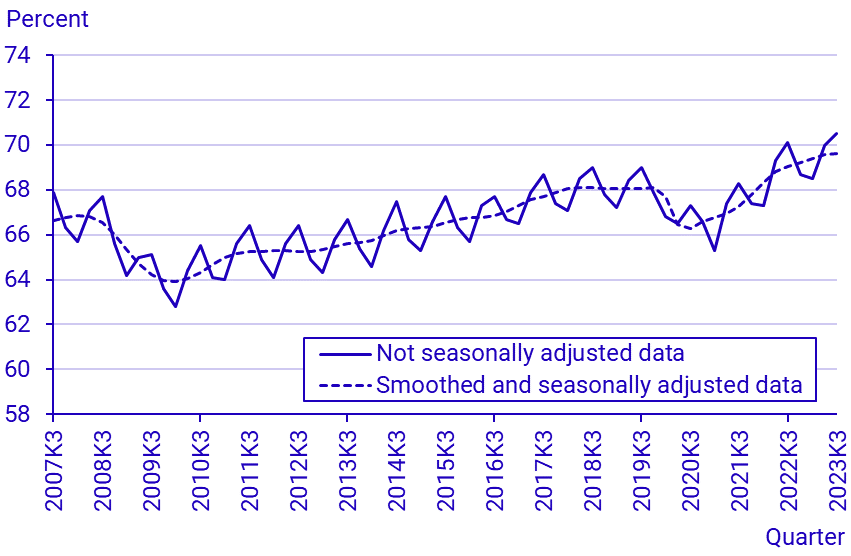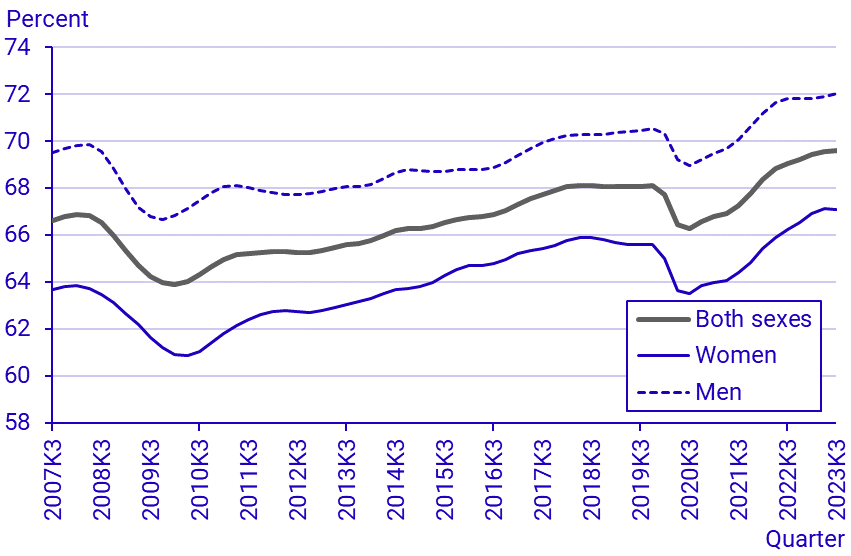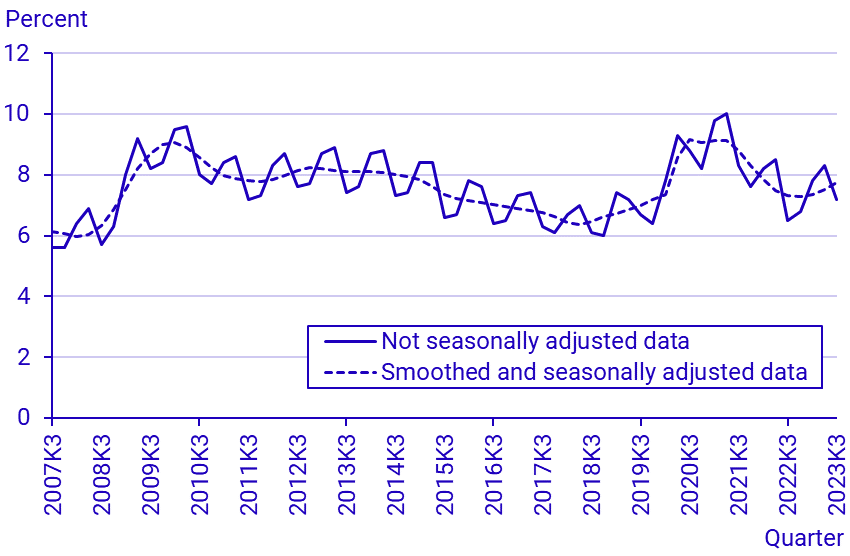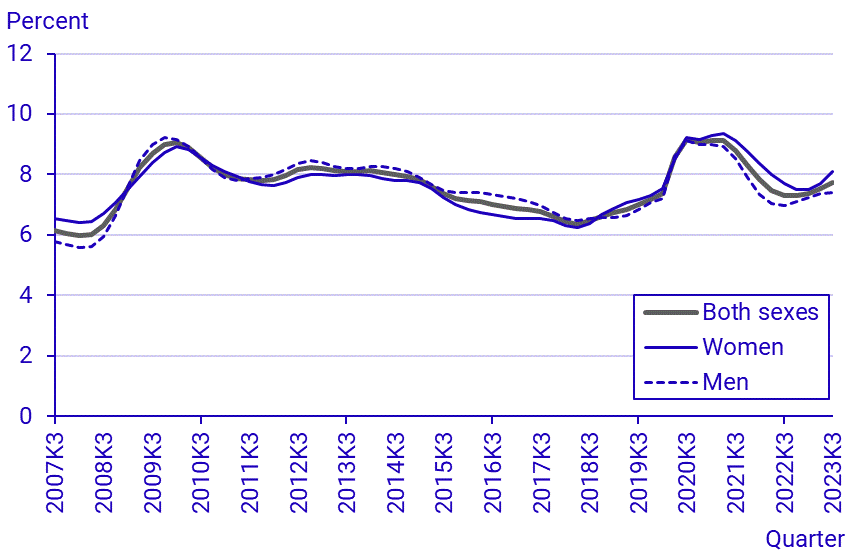Labour Force Survey (LFS), third quarter 2023
Unemployment rises during the third quarter
Statistical news from Statistics Sweden 2023-11-07 8.00
In the third quarter of 2023, the number of employed persons increased by 56 000 to 5 351 000 compared to the corresponding quarter of 2022, not seasonally adjusted. The average number of hours worked per week amounted to 138.8 million hours. There were 418 000 unemployed persons, which is an increase of 49 000 persons. This corresponds to an unemployment rate of 7.2 percent, an increase of 0.7 percentage points. Seasonally adjusted and smoothed data shows an increase in both the number and share of unemployed. The seasonally adjusted and smoothed unemployment rate amounted to 7.7 percent.
– Unemployment increased in the third quarter of 2023. The increase was mainly due to an increase in unemployment among Swedish born persons, says Lena Johansson, statistician at the Labour Force Surveys at SCB.
The labour force
The number of persons in the labour force aged 15-74 years increased by 105 000 and amounted to 5 768 000 during the third quarter of 2023, not seasonally adjusted. The number of women in the labour force amounted to 2 744 000, an increase of 63 000, and the number of men was 3 024 000, an increase of 42 000. The relative labour force participation rate increased by 1.1 percentage points and amounted to 76.0 percent. Among women, the labour force participation rate amounted to 73.6 percent, an increase of 1.4 percentage points, and the labour force participation rate among men was 78.3 percent.
Seasonally adjusted and smoothed data shows an increase in the number and the share of persons in the labour force compared to adjacent quarters. The number of persons in the labour force during the third quarter of 2023 amounted to 5 729 000, which corresponds to 75.4 percent of the population.
Employment
In the third quarter of 2023, there were 5 351 000 persons aged 15–74 in employment, not seasonally adjusted, which was an increase of 56 000 compared to the third quarter of 2022. This corresponds to an employment rate of 70.5 percent. Among women, the number of employed was 2 527 000 and the number of employed men amounted to 2 824 000. The employment rate for women was 67.7 percent and among men it was 73.1 percent. There were 593 000 young people aged 15–24 years in employment. The employment rate for people aged 15-24 was 49.7 percent.
Seasonally adjusted and smoothed, the number of people employed during the third quarter of 2023 amounted to 5 286 000, which corresponds to an employment rate of 69.6 percent.
Employees
In the third quarter of 2023, there were 4 827 000 employees, not seasonally adjusted. This was an increase of 45 000 compared to the corresponding quarter of the previous year. Among those, 2 375 000 were women and 2 452 000 were men. There were 4 073 000 permanent employees, an increase of 98 000. Among permanent employees, the number of women increased by 58 000 to 1 972 000 and the number of men was 2 101 000, an increase of 41 000. There were 754 000 temporary employees, a decrease of 53 000. Among them 403 000 were women, a decrease of 32 000, and 351 000 men.
Compared to adjacent quarters, seasonally adjusted and smoothed data shows an increase in the number of permanent employees and a decrease in temporary employees. According to seasonally adjusted and smoothed data, the number of employees was 4 764 000. The corresponding figure for permanent employees was 4 070 000 and for temporary employees 694 000.
Hours worked
The average number of hours worked per week in the third quarter of 2023 amounted to 138.8 million hours, not seasonally adjusted. According to seasonally adjusted and smoothed data, the number of hours worked averaged to 156.1 million per week. This is a decrease compared to adjacent quarters.
The majority of employed persons have an agreed working time of 35 hours or more per week, that is, full-time work. In the third quarter of 2023, 4 234 000 persons worked full time. Among them 1 853 000 were women and 2 381 000 were men. In total, 222 000 persons worked short part-time (1–19 hours), and the number of persons who worked long part time (20-34 hours) amounted to 631 000 persons.1
The average actual hours worked among employed persons aged 15–74 years decreased by 0.5 hours and amounted to 26.0 hours per week in the third quarter of 2023. Women worked 23.8 hours per week, a decrease by 0.5. Men worked 28.0 hours per week.
Underemployment
Among employed persons aged 15–74, 345 000 were underemployed in the third quarter of 2023. This corresponds to an increase of 40 000 compared to the third quarter of 2022. The number of underemployed women amounted to 156 000 and the number of men was 189 000, an increase of 29 000. Underemployed persons accounted for 6.4 percent of employed persons.
Unemployment
In the third quarter of 2023, there were 418 000 unemployed persons aged 15–74, not seasonally adjusted. This is an increase of 49 000 persons compared to the corresponding quarter previous year. The unemployment rate amounted to 7.2 percent, an increase of 0,7 percentage points. There were 218 000 unemployed women, an increase of 30 000, and 200 000 unemployed men. The unemployment rate for women was 7.9 percent, an increase of 0.9 percentage points and the male unemployment rate was 6.6 percent.
For persons aged 15–74, seasonally adjusted and smoothed data shows an increase in the number and share of unemployed persons compared to adjacent quarters. The number of unemployed amounted to 443 000 in the third quarter 2023, which corresponds to an unemployment rate of 7.7 percent.
There were 129 000 long-term unemployed persons (unemployed for at least 27 weeks) aged 15–74 years in the third quarter of 2023, not seasonally adjusted. Among long-term unemployed persons, the number of women was 61 000 and the number of men amounted to 68 000.
There were 124 000 unemployed young persons aged 15–24, not seasonally adjusted. This corresponds to an unemployment rate of 17.3 percent. Among unemployed young people, 46 000 persons were full-time students. For persons aged 15–24, seasonally adjusted and smoothed data shows an increase in the number and the share of unemployed persons compared to adjacent quarters. The number of unemployed young persons amounted to 151 000, corresponding to an unemployment rate of 21.7 percent.
Not in the labour force
The group 'not in the labour force' includes persons who are not classified as employed nor as unemployed. In the third quarter of 2023, there were 1 825 000 persons not in the labour force, which is a decrease of 69 000 compared to the third quarter of 2022. The number of women not in the labour force was 986 000, a decrease of 47 000, and the number of men was 839 000.
Among persons not in the labour force, the number of retired persons decreased by 37 000 to 849 000, 352 000 were full-time students and 301 000 persons reported that they were on long-term sick leave.
Latent job seekers
There were 261 000 latent job seekers aged 15–74 years in the third quarter of 2023. Among them, 124 000 were women and 137 000 were men. Among young people aged 15–24, the number of latent job seekers was 138 000.
Unused labour supply
Unemployed persons, underemployed persons and latent job seekers together comprise the unused labour supply. In the third quarter of 2023, the unused labour supply averaged 22.5 million hours per week, an increase of 1.9 million hours compared to the corresponding quarter in 2022. The unused labour supply corresponds to 563 000 full-time employments with 40-hour work weeks.
Labour market for persons aged 20-64 years
The population presented by the LFS is comprised of persons aged 15–74 years. However, labour market participation among younger and older in this age group is considerably lower for natural reasons, as this group contains large shares of students and retired persons. To better approach what can be seen as the core of the actively working population, the situation of the age group 20–64 years is described in the following section.
The relative labour force participation rate among persons aged 20–64 years amounted to 89.1 percent in the third quarter of 2023, not seasonally adjusted. This was an increase of 1.0 percentage points compared to the corresponding quarter in 2022. For women, the relative workforce participation rate was 87.0 percent, an increase of 1.6 percentage points and for men it was 91.2 percent. Compared to adjacent quarters, seasonally adjusted and smoothed data shows an increase in the labour force participation rate, which amounted to 88.5 percent.
In the third quarter of 2023, the share of employed persons aged 20–64 was 83.3 percent, not seasonally adjusted. For women, the corresponding figure was 80.8 and for men it was 85.7 percent. The employment rate amounted to 82.6 percent according to seasonally adjusted and smoothed data.
According to not seasonally adjusted data, the unemployment rate in the age group 20–64 amounted to 6.5 percent in the third quarter of 2023, an increase of 0.8 percentage points. The unemployment rate among women was 7.1 percent, an increase of 1.0 percentage points, and for men it was 6.0 percent. According to seasonally adjusted and smoothed data the unemployment rate was 6.6 percent which was an increase compared to adjacent quarters.
Swedish born and foreign born persons aged 20–64 years
The relative labour force participation rate among Swedish born persons aged 20–64 years was 89.6 percent in the third quarter of 2023, not seasonally adjusted. This was an increase of 0.7 percentage points compared to the corresponding quarter last year. Among Swedish born women it was 88.2 percent and among Swedish born men it was 90.9 percent. Among foreign born persons aged 20–64 years, the relative labour force participation rate was 88.0 percent, an increase of 2.2 percentage points. The corresponding figure among foreign born women was 83.6 percent, an increase of 3.8 percentage points, and 92.2 percent among foreign born men. According to seasonally adjusted and smoothed data, the labour force participation rate was 88.9 percent among Swedish born persons and 87.4 percent among foreign born persons. There was an increase in the share of the labour force, both among Swedish born and foreign born persons compared to adjacent quarters.
In the third quarter of 2023, the share of employed Swedish born persons aged 20–64 was 86.2 percent, not seasonally adjusted. Among Swedish born women, the employment rate was 85.0 percent and among Swedish born men the employment rate was 87.4 percent. Among foreign born persons, the employment rate was 75.6 percent, an increase of 1.9 percentage points. Among foreign born women, the employment rate increased by 3.5 percentage points to 69.6 percent and among foreign born men it was 81.3 percent. Seasonally adjusted and smoothed data shows that the employment rate was 85.4 percent among Swedish born persons and 75.1 percent among foreign born persons, of which the latter was an increase compared to adjacent quarters.
The relative unemployment rate among Swedish born persons aged 20–64 years was 3.8 percent in the third quarter of 2023, not seasonally adjusted. This was an increase of 1.0 percentage points compared to the corresponding quarter in 2022. Among Swedish born women, the unemployment rate was 3.6 percent, an increase of 1.1 percentage points. The male unemployment rate increased by 0.9 percentage points to 3.9 percent. The unemployment rate among foreign born persons was 14.1 percent. Among foreign born women it was 16.8 percent and among foreign born men the corresponding number was 11.8 percent. Seasonally adjusted and smoothed data shows that the unemployment rate was 3.9 percent among Swedish born persons and 14.1 percent among foreign born persons. This was an increase for both Swedish born and foreign born persons compared to adjacent quarters.
1) Agreed working time in 2021 and 2022 excludes secondary jobs, this because the agreed working time in secondary jobs has not been collected since the implementation of the EU regulation 2019/1700. As of January 2023, the question regarding agreed working time in secondary jobs was reintroduced and total agreed hours worked are again reported in the Swedish LFS. However, comparisons with the corresponding quarter of the previous year are excluded during 2023.




Source: Statistics Sweden
Definitions and explanations
Since the LFS is a sample survey, the results are subject to some uncertainty. The LFS basic tables contain uncertainty figures and refer to non-seasonally adjusted data.
Seasonally adjusted and smoothed data (trend values): data in which normal seasonal variations have been removed, then smoothed to reduce sampling error and short-term variations. Seasonally adjusted and smoothed data may be revised following new monthly outcomes and usually does not coincide with non-seasonally adjusted data. Seasonally adjusted and smoothed data is not to be compared with non-seasonally adjusted data.
More detailed results are available in the form of figures and tables on employed persons, hours worked, unemployed persons and more, on Statistics Sweden’s website.
Next publishing will be
2023-11-17, at 08:00.
Feel free to use the facts from this statistical news but remember to state Source: Statistics Sweden.
